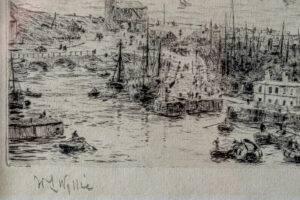 TG sent me a lovely etching of Scarborough Harbor in England circa 1920 at thirteen by five inches. She asked if I know the artist. I do. The artist is a maritime painter of British ships, ports and rivers in the late 19th early 20th century, William Lionel Wyllie (1851-1931). By 1907 Wyllie became a leading maritime artist, known for his oils, etchings, and watercolors. His etchings are delicate and atmospheric. I bought an etching of his for my son, an image of Clydebank in Scotland, a port, along with Scarborough, which was one of the leading shipbuilding locations in the world in the 19th century. My son’s great-great-grandfather built ships in the Clydebank.
TG sent me a lovely etching of Scarborough Harbor in England circa 1920 at thirteen by five inches. She asked if I know the artist. I do. The artist is a maritime painter of British ships, ports and rivers in the late 19th early 20th century, William Lionel Wyllie (1851-1931). By 1907 Wyllie became a leading maritime artist, known for his oils, etchings, and watercolors. His etchings are delicate and atmospheric. I bought an etching of his for my son, an image of Clydebank in Scotland, a port, along with Scarborough, which was one of the leading shipbuilding locations in the world in the 19th century. My son’s great-great-grandfather built ships in the Clydebank.
I discovered that between 1785-1810, two-hundred and nine ships were built at Scarborough Harbor, with a tonnage of 35,683, they launched fifteen huge ships a year. They launched the ships from cradles on an inclined plane at low tide. At this time 1,500 seamen, including five-hundred from the East India Company, belonged to the port. They exported corn, butter, hams, bacon, salt fish. Imports consisted of coal, lumber, hemp, flax, iron, brandy, and wine. In 1849 a company formed to repair huge ships. In the etching we see their floating dock capable of taking ships up to three-hundred tons.
Wyllie fell in love with the sea and ships at an early age
Wyllie came from a family of artists and painted what he loved. At 15 years-old he enrolled at the Royal Academy Schools in London with famous teachers John Everett Millais, Frederic Leighton, and John Henry Landseer. In 1869 the Royal Academy admitted his first painting. That year, at age eighteen, he also won the prestigious Turner Gold Medal with his landscape Dawn After a Storm.
His favorite artist was JMW Turner, about whom he authored a book in 1905, hence Wyllie’s lifelong interest in atmosphere and water.
He not only sketched and painted boats, he owned many and designed a few. He served as commodore of many a British yacht club. His first boat Ladybird, essentially a floating studio on which he invited fellow painters on expeditions up the River Thames 1880-1885. These resultant watercolors of the River Thames showed life in many wharves and in many harbors. The subject matter was vast in 1880s London, the premier port and the largest center of commerce in the British Empire. Because Wyllie needed funds to support his travels on shipping and cruise vessels, he painted ship portraits for sea captains.
In the 1880s he worked for the magazine Graphic as an documentarian illustrator, work different from an artist’s work: as an illustrator, he got all the details right, including no imaginative flights of fancy, and he rendered all work in black and white. This use of monochrome, after his long career previously as a watercolorist, changed the way he saw.
He began to etch in 1883
Drypoint engraving, which uses a diamond pointed needle on a metal plate, calls for a reversed image to be created on the metal, which is then inked and pressed, as we see in Scarborough Harbor. Commercial printwork comprised much of his career for fifty years thereafter. He also etched, mainly a chemical process; engraving is a physical process. With an etching, the image is created on a wax coated metal plate with a burr; once the metal is chemically bathed, the lines of the image appear.
He etched images of the River Thames, London ports, Scottish and Yorkshire ports, yachting, the Mediterranean, the Royal Navy, WWI vessels, sea battles, and images of a new pass-time, cruising, for the very wealthy.
In 1914 the Royal Navy commissioned Wyllie to document WWI on the sea. He painted accurate battle scenes from firsthand observations. His son Roger, at the front as a pilot in the Royal Flying Corps, sent him images.
As the final salvo of his long career, he painted a forty-two foot panorama of the Battle of Trafalgar 1805 between the British Navy and the French and Spanish Navies, unveiled at the Royal Naval Museum at Portsmouth by King George V in 1930. Wyllie died in 1931 and received full naval honors. His body was rowed up Portsmouth harbor in a Naval cutter past battle ships with the colors dipped.
GH’s etching is worth $300.
Pingback: 250-Year-Old English Engraving Important to History - Elizabeth Appraisals